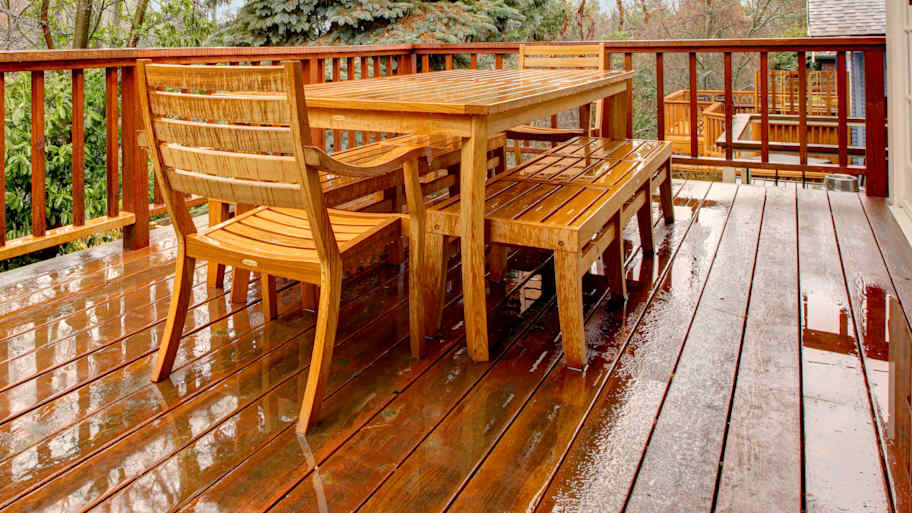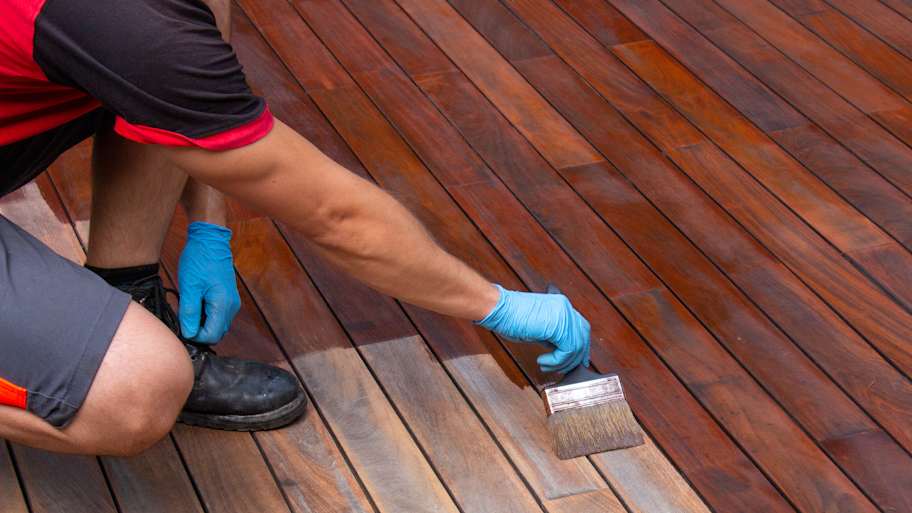
Refinishing your deck is a great way to restore its appearance and fall in love with your outdoor space. Use this guide to learn how much it costs based on factors like size and type.
Don’t let deck stain mishaps spoil your outdoor oasis


Deck stain won’t absorb if you don’t prep the surface properly.
Weather conditions can make or break a staining project.
Ensure any stain you select is suitable for your deck type.
The average cost to professionally stain a deck ranges from $550 to $1,250.
Let's get honest about your deck stain problems. When the application goes wrong, the aftermath isn't pretty. Blotchy color and uneven coverage ruin your deck's appearance while exposing the wood to damage from sun, moisture, and foot traffic. If your stain won't stick, fades too quickly, or flakes like a bad sunburn, here's a closer look at the most common causes and how to fix them.
One of the biggest mistakes homeowners make when learning how to stain a deck is applying stain to a dirty, wet, or previously finished surface without proper prep. If the wood isn’t thoroughly cleaned and sanded, the stain can’t penetrate, leading to patchy coverage or peeling.
Clean your deck thoroughly with a cleaner or wood brightener to remove dirt, mildew, and old stains.
Rinse well and remove all cleaner residue.
Let the wood dry completely until the moisture content is below 15% before staining.
Inspect for damage and replace any rotted or severely warped boards.
Tighten or replace loose fasteners.
Sand rough or fuzzy spots.
Sweep or blow off debris just before staining.

Too hot, too cold, too wet? Weather can make or break your staining project. Staining during extreme temperatures or before rain can cause bubbling, poor absorption, or sticky, uneven finishes.
Check the forecast for ideal staining temperatures between 50°F and 80°F.
Avoid staining in direct sunlight to prevent the stain from drying too quickly, which disrupts absorption.
Allow proper curing time of 24 to 72 hours.
Skip staining on windy days so dust, dirt, and debris do not contaminate the stained surface while drying.
Not all stains work well with every wood type or condition. Choosing a product that’s too thick, transparent, or incompatible with a previous finish can lead to issues like blotchiness, poor adhesion, or a color mismatch.
Match the stain type to your wood and any existing finish.
Pick the right opacity; transparent stains show more wood grain, while solid stains offer more coverage.
Do a test patch before committing to a complete application.
Follow the manufacturer's instructions carefully, especially when recoating.

“Less is more” should be your mantra when using deck stain. Applying too much can leave a sticky, tacky surface that peels off in sheets or never fully dries.
Use a brush, roller, or sprayer to apply stain in thin, even coats.
Wipe off excess stain after 15 to 30 minutes or per the manufacturer's instructions.
Allow each coat to dry thoroughly before applying another.
Sand off sticky areas and reapply if necessary.
Sure, there are pros and cons to deck staining. But even a great stain job won’t last forever—UV rays, rain, foot traffic, and time will wear away the protective finish. A job well done requires proper maintenance.
Inspect your deck annually for fading, wear, or mildew.
Clean the surface regularly with a mild deck wash or a pressure washer.
Reapply stain every 2 to 3 years, depending on the product and exposure.
Add a fresh coat of sealant in between staining jobs for extra protection.
Not sure if your deck is suffering from stain issues? Here are the telltale signs something’s not right:
Patchy, uneven color or shiny spots
Peeling or flaking finish
Sticky or tacky surface days after staining
Faded or dull appearance
Water no longer beads on the surface
Mold or mildew growing in the stain
Blistering or bubbling stain film
Some deck stain problems homeowners can tackle, but more serious issues may require professional help. If your deck has multiple layers of old stain, significant peeling, or signs of water damage, a local deck pro can properly strip, sand, and stain using the right products for your deck type and climate. An expert can also verify if your deck has structural issues.
Homeowners can expect the cost to stain a deck to range from $550 to $1,250, depending on labor costs and the size and condition of your deck. If DIY fixes haven’t worked or you want a long-lasting, low-maintenance finish, bringing in a pro could save you time, stress, and future repairs.
From average costs to expert advice, get all the answers you need to get your job done.

Refinishing your deck is a great way to restore its appearance and fall in love with your outdoor space. Use this guide to learn how much it costs based on factors like size and type.

Are you wondering what factors might affect a wraparound porch’s cost? Budget for this rustic and charming addition with our cost guide.
Deck repair costs depend on materials, damage you need to fix, and more. See how much it costs to replace or repair a deck in Columbus, OH.

A tired-looking deck doesn’t mean you have to replace the entire thing. Learn about these common PVC decking problems and how you can fix them.

Improve your DIY skills and create new ones by learning how to build a pergola of any kind using your knowledge of a few universal steps.

If your deck is in bad shape, this deck repair checklist will help you inspect, clean, maintain, and repair it without missing any vital steps in the process.